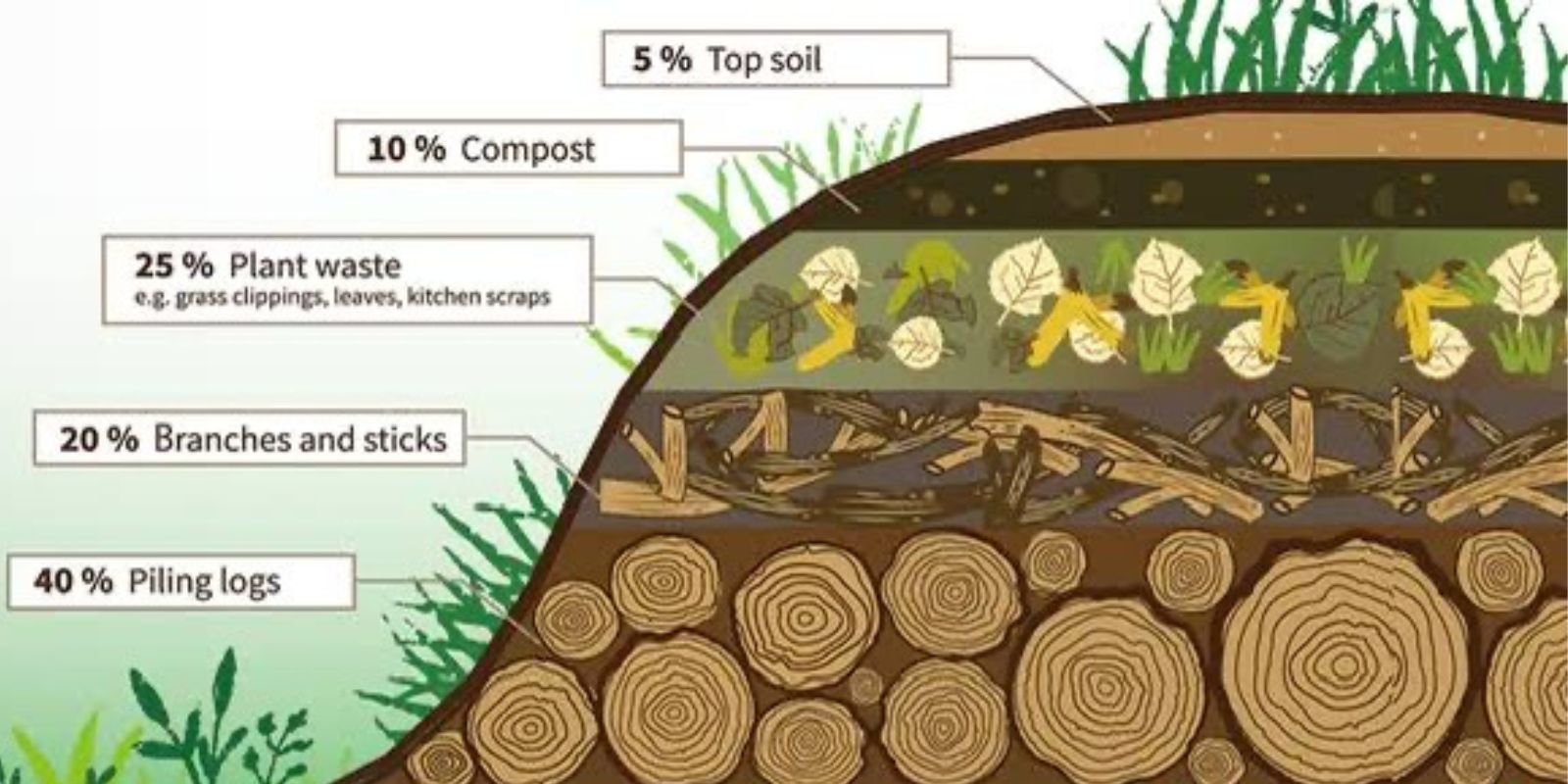If you’re looking for an innovative and eco-friendly gardening method that boosts soil fertility, retains moisture, and reduces waste, Hugelkultur is the solution. Originating from Eastern Europe, this ancient technique is gaining global popularity for its efficiency and sustainability. Hugelkultur, meaning “hill culture” in German, involves creating raised garden beds with layers of organic materials like logs, branches, and compost. The result? A thriving, nutrient-rich environment for your plants.
This guide will take you through everything you need to know about Hugelkultur beds—from how to build them step-by-step to why they’re a game-changer for gardeners everywhere.
What Is Hugelkultur?
At its core, Hugelkultur is a form of permaculture gardening that mimics natural forest ecosystems. It involves burying wood and other organic materials under a mound of soil to create a self-sustaining growing environment. As the wood decomposes, it releases nutrients into the soil, retains moisture like a sponge, and creates an ideal habitat for beneficial microorganisms and fungi.
Unlike traditional gardening methods, Hugelkultur reduces the need for frequent watering and fertilizing, making it an excellent choice for those seeking low-maintenance gardening solutions.
Why You Need Hugelkultur in Your Garden
- Improved Soil Fertility: The decomposing wood and organic materials release essential nutrients into the soil over time, promoting plant growth.
- Water Retention: The sponge-like nature of the wood holds moisture, reducing the need for frequent watering, even during dry periods.
- Reduced Waste: Hugelkultur repurposes garden debris, branches, and other organic materials that would otherwise go to waste.
- Climate Resilience: These beds perform well in various climates, from drought-prone areas to regions with heavy rainfall.
- Enhanced Microbial Life: The decomposition process fosters a thriving ecosystem of microbes and fungi, which further enrich the soil.
- Extended Growing Season: The heat generated by decomposition can slightly warm the soil, allowing for earlier planting in spring.
Step-by-Step Guide to Building a Hugelkultur Bed
Step 1: Choose the Right Location
Select a sunny spot in your garden with good drainage. While Hugelkultur beds can work in shady areas, full sunlight maximizes their productivity.
- Size and Shape: Determine the size of your bed based on your space and gardening needs. Typical Hugelkultur beds are 3-6 feet tall but can be smaller for raised bed gardens.
Step 2: Gather Materials
You’ll need the following:
- Wood: Use logs, branches, and twigs as the base. Avoid treated wood or allelopathic types like black walnut, which can inhibit plant growth.
- Organic Layers: Grass clippings, leaves, straw, and compost.
- Soil: Topsoil to cover the mound.
- Optional: Cardboard or newspaper to suppress weeds as the base layer.
Step 3: Prepare the Foundation
Start by clearing the area of weeds and grass. If desired, lay a layer of cardboard or newspaper at the bottom to suppress weeds and improve water retention.
Step 4: Build the Base with Logs
Place the largest logs and branches at the bottom of the bed. This foundation acts as the primary water reservoir and nutrient source.
- Arrange the logs to create a stable structure.
- Fill gaps with smaller twigs and branches for better compaction.
Step 5: Layer Organic Materials
Add layers of organic matter over the logs:
- First Layer: Add grass clippings, straw, or leaves.
- Second Layer: Add compost or well-rotted manure to provide immediate nutrients.
These layers will break down over time, enriching the soil.
Step 6: Top with Soil
Cover the mound with a thick layer of nutrient-rich topsoil (6-12 inches deep). This layer will serve as the planting surface. Shape the bed into a gentle slope for better stability and easier planting.
Step 7: Plant Your Crops
Choose plants suited to your climate and growing season. Hugelkultur beds work well for a variety of crops, including:
- Vegetables like tomatoes, cucumbers, and squash.
- Herbs like basil, parsley, and mint.
- Flowers for pollinators, such as marigolds and zinnias.
Step 8: Water and Maintain
While Hugelkultur beds retain water efficiently, you’ll need to water them initially to help the wood and organic materials settle. Over time, they require less maintenance as the decomposition process takes over.
- Add mulch to retain moisture and suppress weeds.
- Monitor the bed’s structure and replenish soil or organic matter as needed.
Tips for Successful Hugelkultur Beds
- Start Small: If you’re new to Hugelkultur, begin with a smaller bed to familiarize yourself with the process.
- Use What You Have: Repurpose fallen branches, pruned twigs, and garden waste to build your bed.
- Adjust for Climate: In dry regions, bury the logs deeper to improve water retention. In wet areas, raise the bed higher for better drainage.
- Companion Planting: Combine plants with similar water and sunlight needs to maximize productivity.
- Avoid Certain Woods: Stay away from woods that take too long to decompose, like cedar, or those that release toxins, like black walnut.
Common Mistakes to Avoid
- Skipping the Soil Layer: Without a sufficient topsoil layer, plants won’t thrive.
- Using Fresh Wood: Use partially rotted wood for faster decomposition and better results.
- Overwatering: While Hugelkultur beds retain water, excessive watering can lead to rot and nutrient leaching.
Why Hugelkultur Is the Future of Gardening
As climate change continues to impact traditional gardening practices, Hugelkultur offers a sustainable solution. It requires fewer resources, minimizes waste, and promotes biodiversity. Whether you’re an experienced gardener or a beginner, this method is a fantastic way to create a resilient and productive garden.
Conclusion: Start Your Hugelkultur Journey Today
Hugelkultur beds are more than just a gardening trend—they’re a proven technique for sustainable living. By building your own Hugelkultur bed, you’ll not only improve your garden’s productivity but also contribute to a greener planet.
🌱 Have you tried Hugelkultur? Share your experience below and let us know what you’ll plant! 💬

